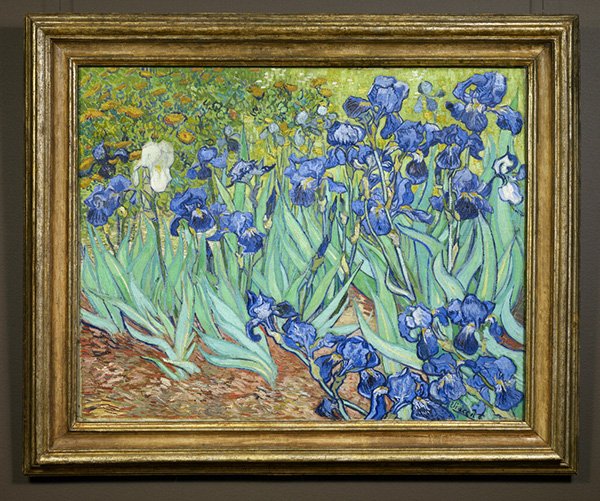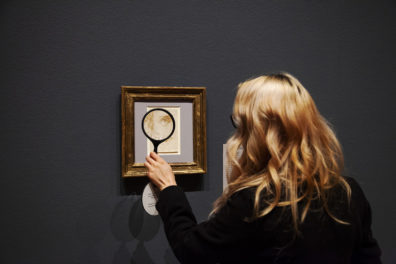Capturing the spirit of The Irises in over 60 beautiful haiku

Irises, 1889, Vincent van Gogh. Oil on canvas, 29 1/4 x 37 1/8 in. The J. Paul Getty Museum, 90.PA.20
To celebrate Vincent van Gogh, who was born on March 30, 1853, we invited visitors to share their thoughts in haiku form.
Haiku are short imagistic poems that, like Van Gogh’s paintings, capture a moment in time: sunflowers going to seed, boots untied after a day’s labor, irises blooming in a walled hospital garden. And like Van Gogh’s paintings, haiku speak to us directly and humbly. “Haiku has ‘white space’ that invites the reader to have a conversation with the poem,” Deborah P. Kolodji, haiku instructor and moderator of the Southern California Haiku Study Group, told me.
Van Gogh was drawn to Japanese art, pinning prints to his studio walls and studying them closely. As he wrote to his brother Theo in 1888, less than a year before entering the asylum where he painted The Irises:
If we study Japanese art, then we see a man, undoubtedly wise and a philosopher and intelligent, who spends his time—on what?—studying the distance from the earth to the moon?—no; studying Bismarck’s politics?—no, he studies a single blade of grass.
Haiku are usually described as three-line poems of 5, 7, and 5 syllables, but sharing a feeling, contemplating that blade of grass, is the heart of the form—not counting beats. “What’s important is to briefly capture the pure essence of the moment without adding extraneous stuff,” Deborah said.
Traditional haiku have a kigo, or “season word,” that both describes the time of year and sets the emotional tone of the poem. (In Japanese, a kireji, or “cutting word,” separates the kigo from an image or action to which it is juxtaposed.) Deborah suggested the kigo “spring melancholy,” which I love for The Irises. She shared:
one white iris
in a mass of blue
spring melancholy
Van Gogh’s single white flower calls to many of us—but everyone has a unique take on it. For visiting English teacher Ellen Knopf, it evoked not melancholy, but tongue-in-cheek battle:
arrow of purple
blossoms point toward white leader
advance on orange!
For others, The Irises is intimately bound with Van Gogh’s biography. Paintings curator Scott Allan found sadness, but also quiet hope:
in the asylum
Vincent, seeking solace, finds
irises teeming
And visitor Kristin Bader summed up what many of us feel in front of The Irises—wonder:
the more that you see
the less your mind retains, but
art is forever
Spring melancholy, solace, humor, wonder—does Van Gogh’s work say this to you? Or does it speak something that only your ear can hear?

Text of this post © J. Paul Getty Trust. All rights reserved.




Provence in summer;
no! The cornflowers’ giving
will no more heal me…
Iris eyes smiling
back at the man who sees
more than a flower
I would like permission to use these words to engrave a brick at Rockefeller Gardens to honor Tony Willott who worked his entire life to plant, nurture, and preserve the Iris Garden there.
March 30, 2011
LA cloud
frothy and gold-lined–
irises
search Irises now
it is eighth in Google search
S.E.O. is hard
flowery silhouettes
elegantly twisting in the wind
longing personified
fright-ning clarity
iris blues and garden dreams
I suffer, no more
violet flowers
in sea anemone blue
sway my beating heart
reek of seeweed
in the creeping fog —
outdoor art show
grabbing the easel
splashing paint, terrified
who am I?
he talks in golds and yellows
to any fool who’ll
lend an ear
From the renku “The Summer Grass”
http://www.wordsontheweb.net/norman%20darlington.htm
squeezing tubes
burgundy, strawberry, apple green
all fired up
green snakes slither up
biting as bluebirds lift off
mouths open, screaming
Blue of iris
dreams of spring
life abounds
white iris
the walled garden
brightens
Here’s one inspired by his drawing of Arles, also from the Getty collection:
http://www.getty.edu/art/gettyguide/artObjectDetails?artobj=141987
A thousand brown marks
Suddenly chaff, smoke, rooftops
I’m breathless, looking
swirling stars
the whirling thoughts
of Vincent
pupils study
Vincent’s Irises;
his blue eyes
cresting of waves
a dance in the wind
my garden’s delight
twisting stems reaching up
high to drink in the sun’s warmth
just like all of us
irises
within and without
l’hôpital
twisting stems reaching
high to drink in the sun’s warmth
just like all of us
her eyes open wide
in a field of gold
hundreds of sunflowers
They share a birthday
She will not cut off her ear
I stand vigilant
a work in progress
merely a study, you say
but the flowers bloom
dancing blades
blue blossoms
ballet his and mine
open your warm heart
and let me taste your nectar
sensuous flower
Ouch, my friggin ear
i mistook it for meat
and ate it on toast
van gogh’s irises
a man leans
toward his wife
starry starry night—
unfinished art school paintings
in the dumpster
Originally published in Heron’s Nest VI:2, March 2004
http://www.theheronsnest.com/haiku/0603o1448/thn_issue.h4.html
Vincent’s birthday blues
glacial ice frozen in oil
iris held hostage
what the spirit needs
starry nights and blloms of white
wash over moods of blue
arm in arm
they stroll
Rhone reflections
the night sky
again in the irises
the swirl of life
Starry night in March
Vincent blooms into sunflower
Does he hear our praise?
van Gough’s Birthday
my invisible avatar
among his irises
Caught in fluid form
iris blues invite
earth aches…
blue framed glasses
match flaming irises
lone white flower…
so much wonder
in a flowery gaze
music of the earth…
so much wonder
where flowers glance
van gogh hides…
bid flowers still night
after so much dancing in breeze
I go count stars…
🙂 next time
iris will dance for me
van gogh said so…
~
Starry starry night
paint brushes left out to dry
alone with crickets
Vase of sunflowers
a dried twisted tube of
summer yellow paint
at Cafe Terrace, I fall
inside your glass of wine
the night pierced with stars
sorry, a computer glitch, should be Cafe Terrace not Terarce
purple ink
welled deep within
the iris becomes a poem
blue iris, sad blue eyes
tearless cries and fake smiles
stand with pride, shattered heart
the irises bloom
in the hospital garden
his final breath
iris dance
to music unheard
blues into blue
descending tram–
across my lap a poster
of the irises
irises bloom
in burnt fields
I paint the stars
twilight in the park
the last light
lingers in the irises
last light lingers
in my hands
a purple iris
a purple iris
waving in air
my arms rise and fall
my arms rise and fall
as the moon appears
indigo deepens
indigo deepens
in the sky
dancing with irises
dancing with irises
I sing with Vincent in the park
starry night
or
irises blooming
in burnt fields
as I paint the stars
iris by iris
Vincent paints peace on canvas
tinnitus quiets
On Van Gogh’s “The Novel Reader.”
yellow book, bookcase
bent in dark concentration
she sucks up light
starry night
i count
my blessings
yet another spring
this frenzy
of purple iris
red vineyard
vanishing in the sun
the grape pickers
originally published in Chrysanthemum #1, April 2007
yearning toward May
a tangle of blue iris
her white winter face
even in asylum
hope exists to fight
the blues
blue green eyes
subject and the artist
blending
on my parents’ blue
bedroom wall, the hay stacks
I hid in
that bed of purple
iris–each day more radiant
the summer you fell ill
Foreseen hope blossoms
from the mist of blue sadness
Irises spring’s joy
unique as one is
inside the garden of life
the rest are many
substance of absence
opens the path going in
to where time has been
these soiled boots rest
before the next forey–
hazey moon
John Daleiden
Phoenix, AZ in the Sonoran Desert
the still reflection
of a slender vase
a spatter of rain
Inspired by Kurosawa’s “Dreams”:
led down a dream path
to a harvest of rainbows
from another’s world
silver screen mirror
reflects a light chaser’s dream
of a light chaser
blues-arching away!
orange glory serenades white bloom….
is Vincent’s story?
im all up in the green and blue
serenity
in the presence greatness